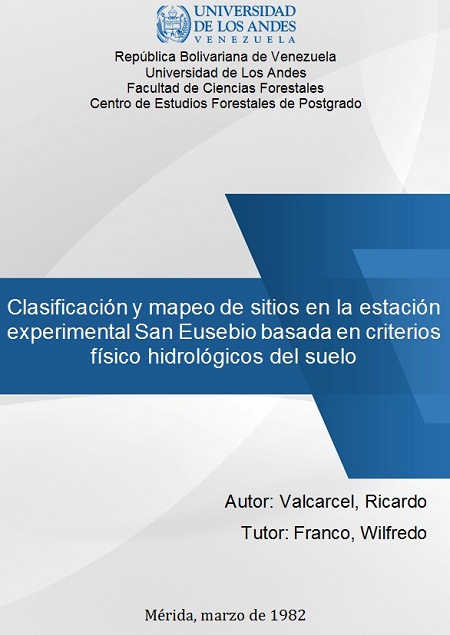Clasificación y mapeo de sitios en la estación experimental San Eusebio basada en criterios físico hidrológicos del suelo
Resumen
Se estudió la caracterización de la relación existente
entre la pendiente del terreno y el régimen hídrico del suelo,
factor de mayor significado ecológico en el área, (Hetsch y Hoheisel
1976). El estudio empleó las siguientes variables del
perfiI del suelo: zona de buen drenaje (Y1), zona de actividad
biológica (Y2), profundidad del inicio de la zona moderadamente
compacta (Y3), espesor de la zona de saturación (Y4), espesor
de la zona de movimiento lateral de agua (Y5) y profundidad
del horizonte Al (Y6). Para ello se efectuaron 97 barrenos
en el sentido de la pendiente, totalizando aproximadamente 4540
metros de longitud, en la Estación Experimental San Eusebio, Mérida - Venezuela. Dicha estación tiene las siguientes características:
clima húmedo (1500 mm/año, 12.6°C y 83% HR del aire),
vegetación Selva Nublada sobre la formación geológica "Colón"
(Iutitas arcillosas), suelo de textura fina, altitud entre 2200-
2600 m.s.n.m.
Una vez definida la relación pendiente - régimen hídrico
de los suelos se formuló una clasificación de sitios para
el área, basada en la pendiente, la geomorfología y las variables
Y1, Y2, Y3 Y Y5 (estadísticamente significativas).
La clasificación propuesta es sencilla y de fácil aplicación
por el usuario, pudiendo ser utilizada en estudios ecológicos,
hidrológicos y de uso de la tierra. En base a ella se
hizo un mapa a escala 1:5000 de sitios edáficos de la Estación
Experimental San Eusebio (368 ha) con recomendaciones para su
uso. The aim of the present study was to characterize the relationship between the terrain slope and the soiI water regime,
the most significant ecological factor in the area, (Hetschand
Hoheisel 1976). The following soil profile variable were used:
Well Drainage Zona (Y1), Biological Activity zone (Y2),Dephat
the beginning of the moderately zone (Y3), Thickness of the Sa
turation zone (Y4), Thickness of the Water Lateral Movement zo
ne (Y5), and Deph to the Al Horizon (Y6). A total of 97 soiI Pits
was made in 9 parallell el transects to the slope, for a total of aproximately
4540 meters length, in the San Eusebio Experimental
Station, Mérida - Venezuela. The experimental station has
the following conditions: humid climate (1500 mm/annual ,12.6°C
and air relative humidity of 83%), cloud forest and "Colón"Geo
logical Formation, clay texture soiIs, and heigth between 2200
to 2600 m.s.n.m.
After the relationship slope and soiI water regime was
defined it was formulated a site classification for the study
area, according to the slope, the geomorfology, and the Y1, Y2,
Y3, Y5 variables (all of them statistically significant). The
site classification is considered simple and of easy application
for the users. It can be used for ecological, hidrological
and land use studies. Based on the site classification, a
edaphic site map at 1 :5000 scale was made for the San Eusebio
Experimental Stat i on (368 ha) with some recomendations for the
site uses.

